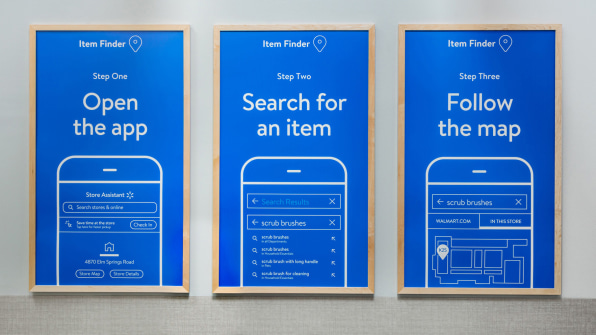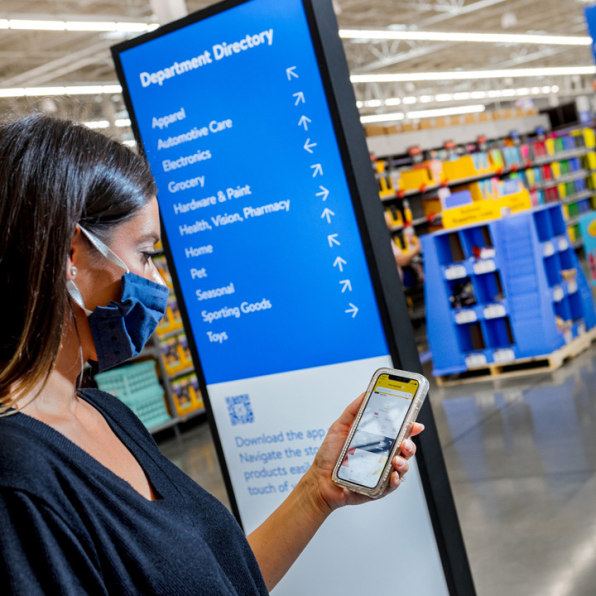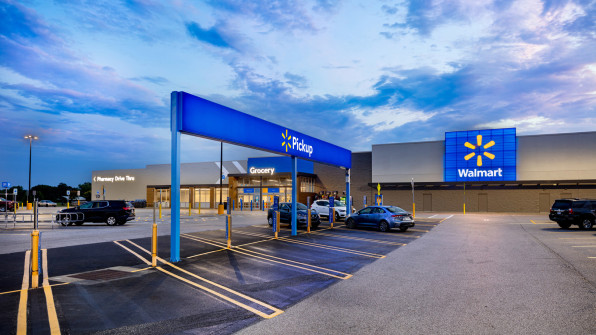See Pictures Why You Might Not Go to Walmart Again
COVID-19 has changed the way we shop. Even with much of the U.Due south. dorsum open for business, online sales were all the same up twoscore% in Baronial versus the twelvemonth prior. And Americans have spent $107 billion more online than they had last year past this point.
The days of lazily strolling through store aisles are over, at least for a while. And nowhere is this trend more clear than in Walmart's new store blueprint, which the company is unveiling for the offset time today. The pattern volition come to 200 stores effectually the U.Southward. by the end of 2020, and 800 more by the end of 2021.
At a glance, information technology honestly might not look that dissimilar. The stores volition all the same have like snug aisles and unfinished, warehouse-style ceilings. Merely the updates are in how y'all navigate that space. Walmart is rearranging many items beyond the store, consolidating categories such as electronics, toys, and baby products into their own dedicated sections rather than having some items scattered. Then they're loading these stores with clearer signs to point you around the space. These signs match up with the verbal categories and icons you'll also find inside the surprisingly cracking Walmart app. The intended effect is what the company is billing as a "seamless" shopping experience between the digital store and the physical 1.
"We've always known customers want to go in and out of a Walmart as quickly every bit they tin. Not in a bad way. You don't want to waste time," says Janey Whiteside, EVP and chief customer officer at Walmart, who adds that this desire has only increased during the pandemic equally people want to feel safety. Speed and clarity become a lot more than important than what retail had been championing before: experience. There will nonetheless be areas to experience products—these special spots will be dubbed "beacons" and allow yous to test strollers or gadgets. But information technology'southward inappreciably the experiential approach to retail pioneered by companies such as Apple tree and even Walmart'southward big-box competitor, Target.
In 2017, Target renovated its make by spending $7 billion redesigning its stores to be more browsable, creating moments of serendipity with sections oftentimes set to spotlight just a few products (which are frequently designed and sold by Target). For Target, the strategy worked near instantly, and by 2018, pes traffic increased to its highest numbers in a decade. Merely to many of us in 2020, the joy of burning a Sunday afternoon with a latte at Target has been overshadowed past the threat of a pandemic petri dish (which is why, as in-store visits stalled, Target's curbside pickup expanded by an unbelievable 734% before this twelvemonth).

Walmart really began its store redesign about a year agone, long before COVID-19. Its goal was to make shopping at Walmart a singular experience in which the app and the store itself spoke the same language. "We're trying to save our customers time, which we know is important to them, and [use] less cognitive load, which nosotros know is of import to them," says Whiteside. "People walk around the store with a phone in their hand looking down and looking up, and nosotros wanted to integrate those things, so when they expect at their telephone they can expect up at [the same thing] in the store." The Walmart app will actually direct customers to the exact locations of items inside the shop, with aisles more than clearly labeled with numbers and messages to help people get a sense of management.

Merely fifty-fifty without a phone in your hand, customers volition be ushered around the store by new signs everywhere. One time they enter, an data board points to the primary sections. Information technology looks a lot like the sort of kiosk you'd encounter at a theme park or an airport. That's by design.

"When nosotros prepare about doing this, the team spent a good amount of time experiencing places where large groups of people gathered and needed to be quickly marshaled, or navigated to somewhere," says Whiteside. "Airports were a identify that inspired us considering, by nature, you don't spend an atrocious amount of fourth dimension in airports, so yous don't know your way effectually. Simply you need to go a lot of people somewhere in a timely way."
Walmart dubbed these tools "navigational efficiencies." And you'll see them when you walk in the door only too in new, oversized blue labels over areas that read things such equally "CHEESE" or "SEAFOOD." For people who don't read English, these giant words might not help much. Just past having the same icons in the multilingual app as on many of the other Walmart store signs, Whiteside argues that people should exist able to translate various sections more easily.

Finally, the new design will make its mark on the outside of the store also. A large blue arch marks the pickup surface area, which should exist visible beyond a parking lot. And even Walmart'south ain sign has changed, from the broad Walmart wordmark to a blue square that mimics its app icon. Without saying a word, Walmart has made an important point: Shopping at Walmart doesn't hateful being inside a Walmart store, sitting in your auto, browsing the Walmart app, or using your PC browser. It's all of those things—and occasionally, it'south a few of those things at the same time.
Source: https://www.fastcompany.com/90557727/walmarts-new-store-design-proves-browsing-is-dead
0 Response to "See Pictures Why You Might Not Go to Walmart Again"
Post a Comment